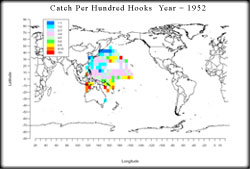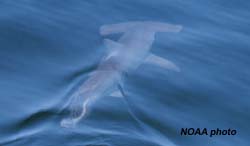|
Predator diversity hotspots in the blue oceanBoris Worm, Heike Lotze, and Ransom A. Myers
PNAS, August 2003 | 
Article as pdf Science NOW article
Large oceanic predators concentrate in unique "diversity hotspots" much like those that exist on land, according to new research published this week in the prestigious U.S. journal "Proceedings of the National Academy of Sciences USA." Many predators, such as tunas, sharks, billfishes, and sea turtles, are of immediate conservation concern due to their vulnerability to overfishing, or high mortality as by-catch in commercial fisheries. Although terrestrial conservation efforts have focused on identifying and preserving such concentrations of vulnerable species, little is known about similar hotspots in the ocean. The scientists found that species diversity peaks at distinct locations, always located at intermediate latitudes (20-30 degrees North and South) where tropical and temperate species overlap. Hotspots are located close to prominent marine geographic features, such as reefs or shelf breaks. They are found east of Florida, south of Hawaii, and off the east coast of Australia, and within national waters. Additional studies show that these hotspot areas seem to be important for many species at once, from plankton to sharks. Through modeling, the researchers predicted that protecting these hotspot areas from fishing would yield greater benefits for threatened species than closing any other area. The scientists suggest that the ocean has unique, and previously unrecognized concentrations of pelagic species, which should be used to focus future conservation measures. They also propose that marine protected areas in national waters, combined with reduced fishing effort, could be used to safeguard threatened marine predators from further declines and ecological extinction. |
|
|
|
Rapid worldwide depletion of predatory fish communitiesRansom A. Myers and Boris Worm
Nature, May 15th, 2003 | 
Changes in the catch per unit effort in the Japanese longline fishery from 1952 to 2000, catch of tuna and billfish per 100 hooks.
Quicktime movie 23 MB Slide show | Analysis of data from five ocean basins reveals a dramatic decline in numbers of large predatory fish (tuna, blue marlins, swordfish and others) since the advent of industrialized fishing. The world's oceans have lost over 90% of large predatory fish, with potentially severe consequences for the ecosystem. These findings provide indirect support for goals established at the UN's World Summit on Sustainable Development in Johannesburg last year. UN officials argued that three-quarters of the world's fisheries were fished to their sustainable limits or beyond, and made proposals for the restoration of depleted fisheries by 2015. Data on predatory fish are important as they are not dependent on datasets from commercial fisheries, which can be unreliable.
GO TO THE WEBSITE |
|
|
|
Collapse and conservation of shark populations in the Northwest AtlanticJulia K. Baum, R.A. Myers, D.G. Kehler, B. Worm, S.J. Harley, and P.A. Doherty
Science, January 17, 2022 |  | Shark populations in the Northwest Atlantic have declined dramatically in the last two decades. Using an extensive dataset from the pelagic longline fishery, Baum and colleages have detected declines ranging from 40% for mako sharks to over 90% for hammerhead sharks. The magnitude of these changes suggests that several species are in danger of large-scale extirpation. The authors call for new marine reserves and a reduction in fishing effort to halt these trends. | Paper on Science website Science Now
This Week in Science |
|
|
|